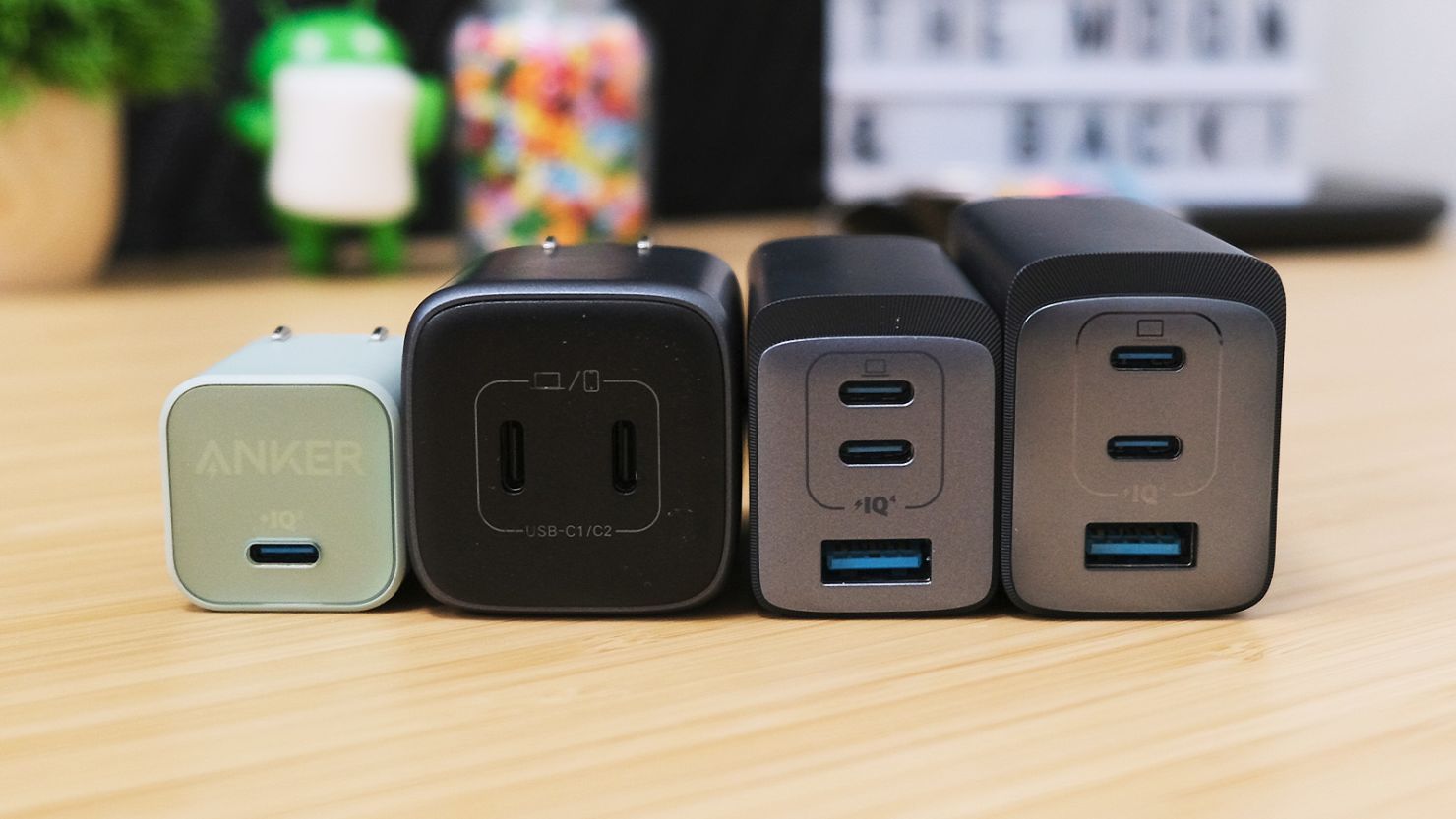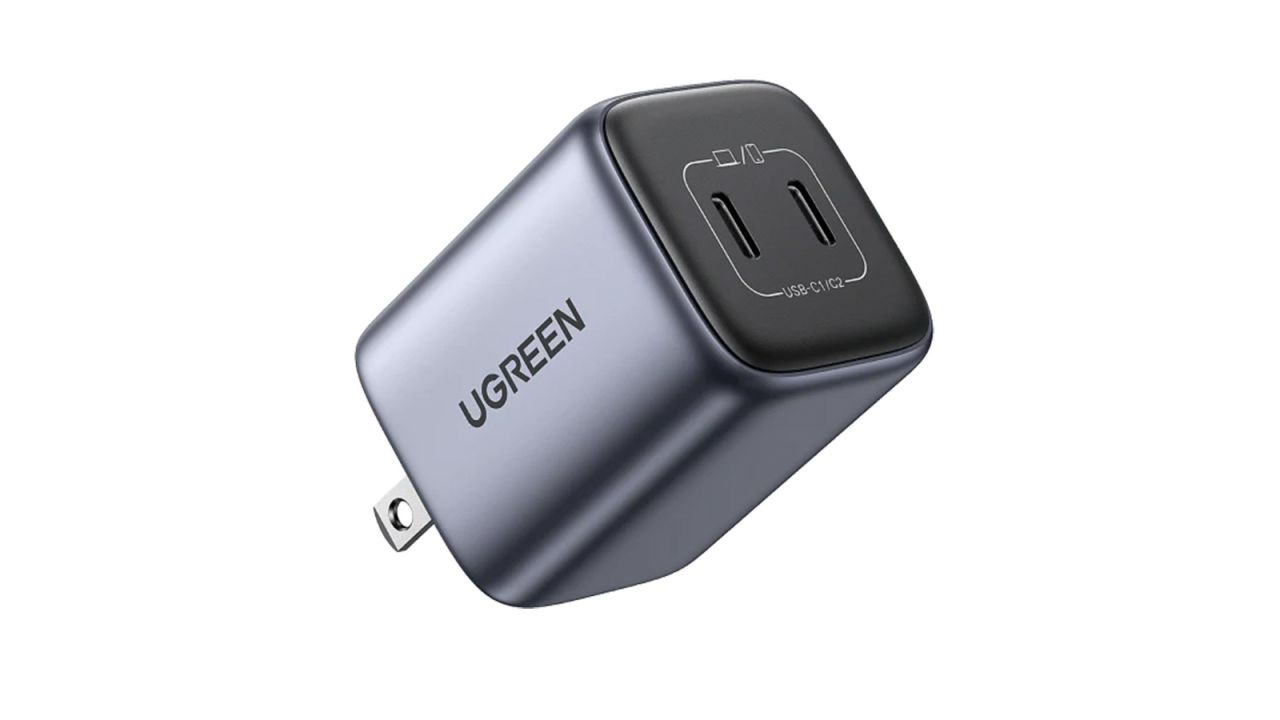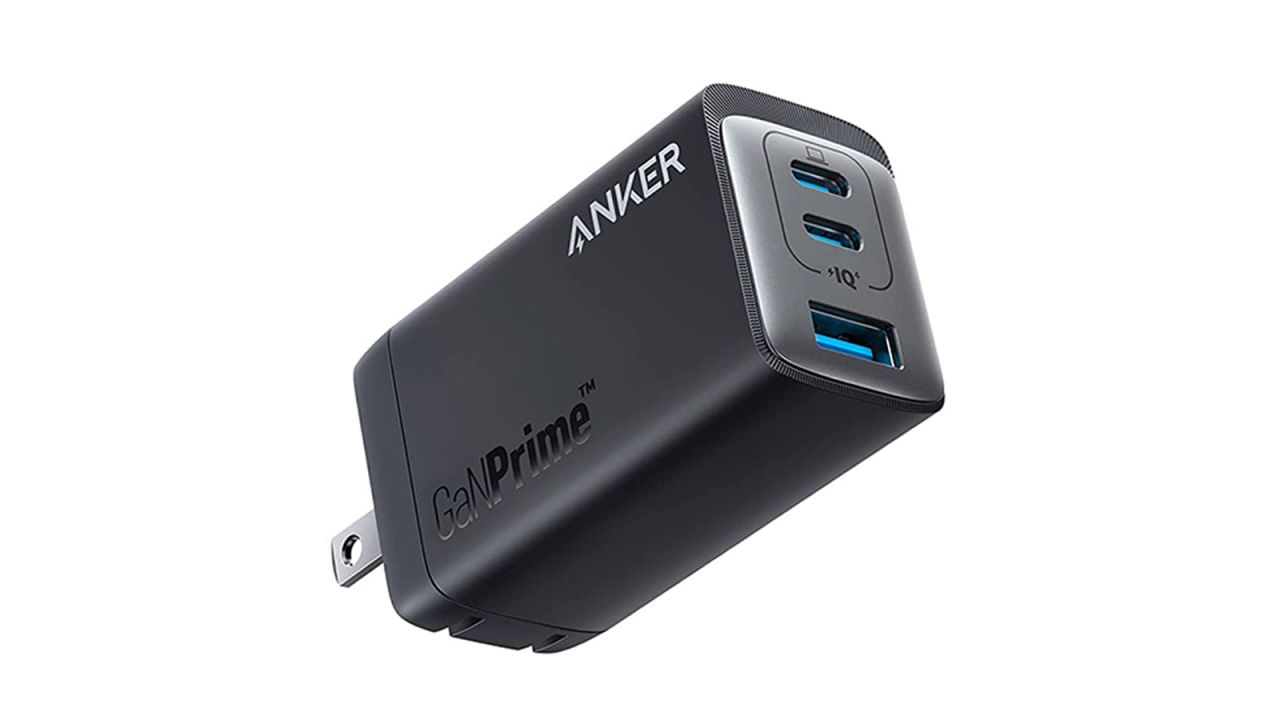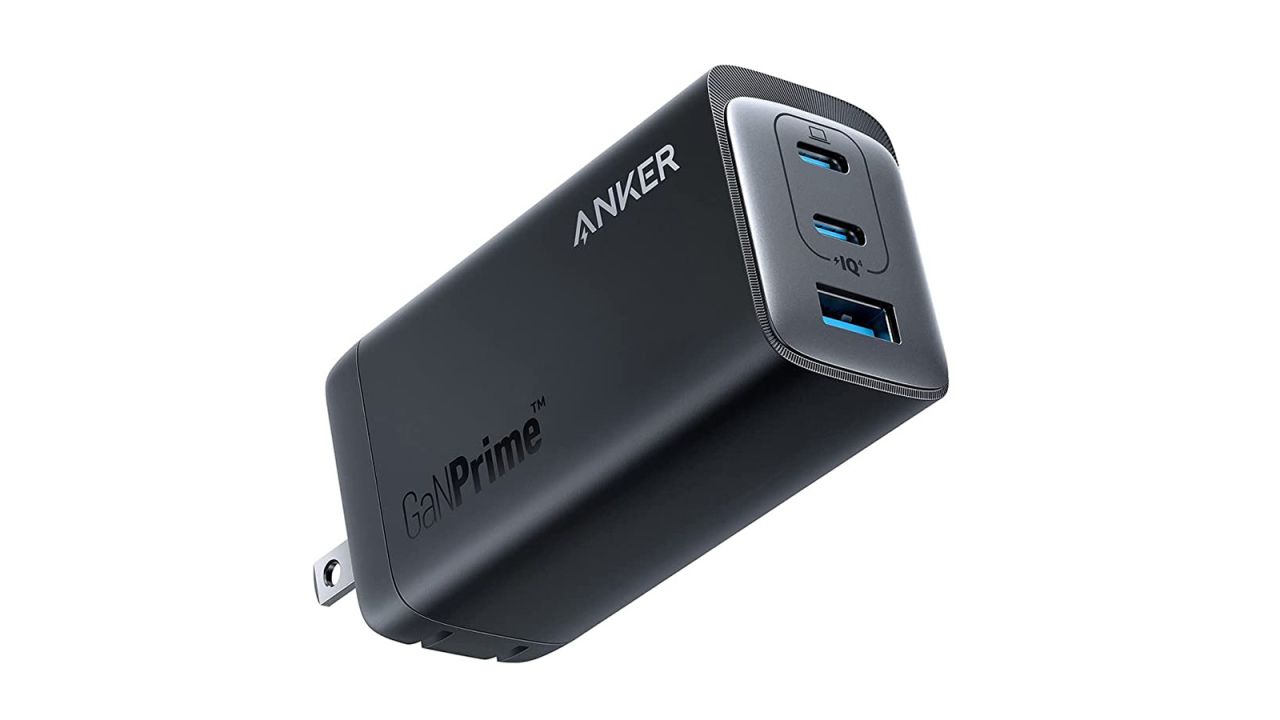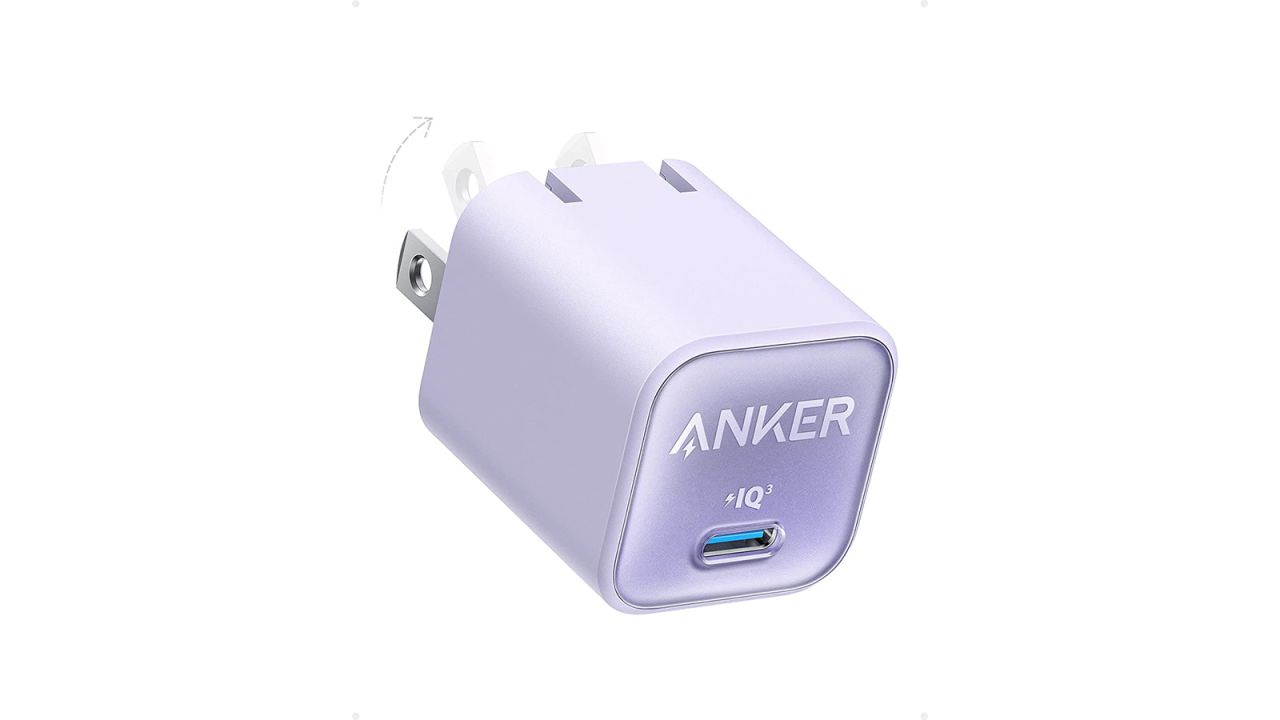With USB-C finally more or less standard across phones, tablets and laptops, and fewer and fewer manufacturers including chargers in the box with their products, you’ve probably found yourself in need of a speedy, high-powered USB-C charger. Luckily, the widespread adoption of Gallium nitride (GaN) — a material that conducts electricity more efficiently and doesn’t get as hot as old-school silicon — means USB-C chargers can be built smaller, lighter and more powerful than ever.
In order to find the best USB-C chargers, we tested 35 different models from respected manufacturers to find the best for your needs, whether you need to charge a phone, tablet, laptop or all three, plus a bagful of accessories.
The only small charger that could fast-charge a Samsung Galaxy phone in our tests, the Nexode has a second USB-C port that lets you split its total capacity for more versatility.
With two USB-C ports for laptops or tablets and a USB-A port for lower-power devices like a phone or smartwatch, the Anker 735 is ideal for getting all of your gear charged at home or on the go.
Similar to the 735, the 737 has a total of three ports, two USB-C and a lone USB-A port, but it ups the power to 120W, making it perfect for a 15-inch laptop plus a smartphone and tablet or other device.
The tiny, affordable Anker 511 Nano 3 cranks out 30W of power, up from 20W last year, can fast-charge an iPhone or Google Pixel and comes in fun colors.
The best USB-C charger for smartphones: Ugreen Nexode Mini 45W
$40 at Amazon

Ugreen’s Nexode Mini isn’t the smallest charger we tested in this output range, but it’s close. The diminutive (1.57 by 1.57 by 1.93 inches, 3.46 ounces) block has two USB-C ports placed side by side on its face; on the backside you’ll find the prongs, which fold into the housing for convenient storage.
The Nexode Mini’s USB-C ports support all the fast-charging standards we tested for, including hitting full 45W charging when connected to Samsung’s Galaxy S23 Ultra smartphone — a rare feat among the charging adapters we tested. Either port can supply the full 45W; if you connect two devices, the output is split between the two ports.
Since the devices themselves determine how much power they’ll draw from a charger, your results will vary slightly depending on what you’re charging. In our testing, using a single port. we got 45W to the Galaxy S23 Ultra, 44W of power to the Surface Laptop Studio, 20W to Google’s Pixel 7 and 26W to an iPhone 14 Plus. With two devices connected we saw 43W of combined output. All things considered, that’s akin to getting straight As at the end of a semester.
Because the Nexode Mini is one of only a few chargers we tested that can actually charge a Samsung device at 45W, and it’s capable of fast-charging all major US brands of smartphones, it’s an easy recommendation for anyone looking for a great phone charger that’s versatile enough to handle a couple of devices in a pinch.
The best USB-C charger for multiple devices: Anker 735 65W
$60 $38 at Amazon
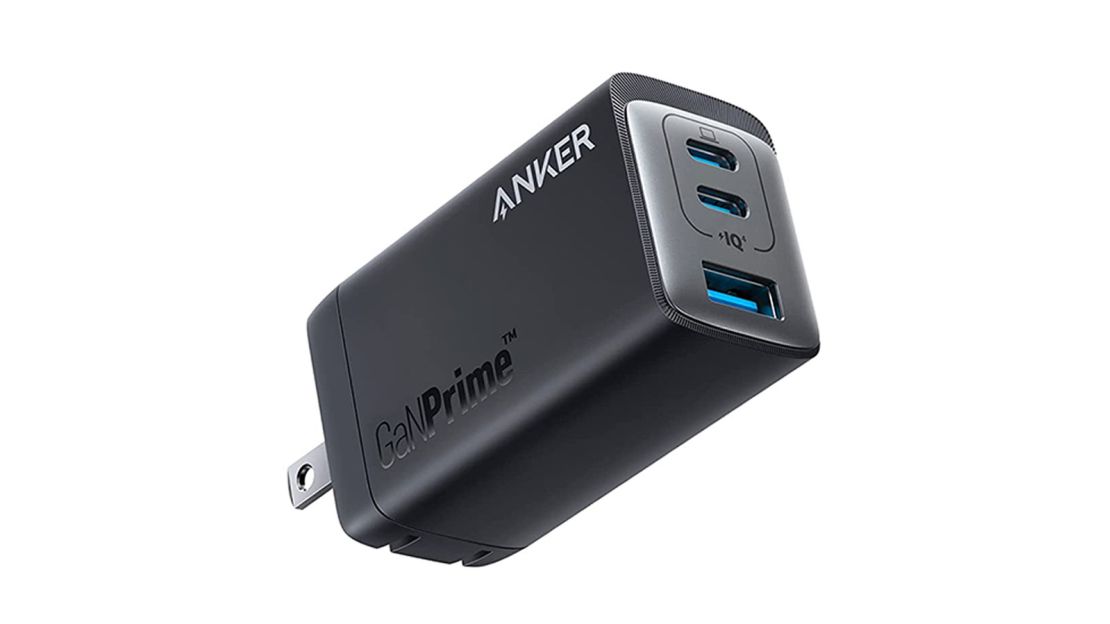
If you’re looking for a charger that can keep your laptop and a tablet (or both) charged at home or on the go, the Anker 735 Charger is our top pick.
On the front of the charger, you’ll find three ports, two USB-C and a single USB-A port, with a maximum total output of 65W between the three. Either USB-C port can provide 65W of power when used on its own, with the USB-A port offering 22.5W when it’s used on its own.
When you need to use two ports, try to avoid using the second USB-C port and the USB-A port. For whatever reason, doing so will limit the total output to just 24W. However, if you use the top USB-C port and the USB-A port, or the two USB-C ports, you’ll get the full 65W of power. And using all three ports, you get the full 65W as well, so the arrangement won’t limit your use of the device in practice.
When testing the 735, we observed a total combined output of 64W, very close to the advertised rating. Testing individual ports, the 735 provided 64W to Surface Studio Laptop, 45W to the Galaxy S23 Ultra, 20W to the Pixel 7 and 26W to the iPhone 14 Plus, telling us that it can support fast-charging on all of those devices.
The only downside is that the adapter’s housing is relatively long (it measures 1.5 by 1.15 by 2.6 inches), and it is one of the heavier (4.65 ounces) out of the 65W chargers we tested, so it’s top-heavy. If you have an older, worn-out wall outlet, it could pull out of the outlet. To prevent that, Anker includes an adapter with suction cups on one side. You slide it over the charger, pressing the suction cups against your wall or the outlet to ensure a snug fit. And since the prongs fold in, the 735 is compact and unlikely to snag or get tangled among cables when it comes time to throw it in a bag.
The Anker 735 supports all of the charging standard we tested, and is more than powerful enough to fast-charge your smartphone and laptop, or a tablet and laptop without breaking a sweat.
The best USB-C charger for 15-inch laptops: Anker 737 120W
$89 $60 at Amazon
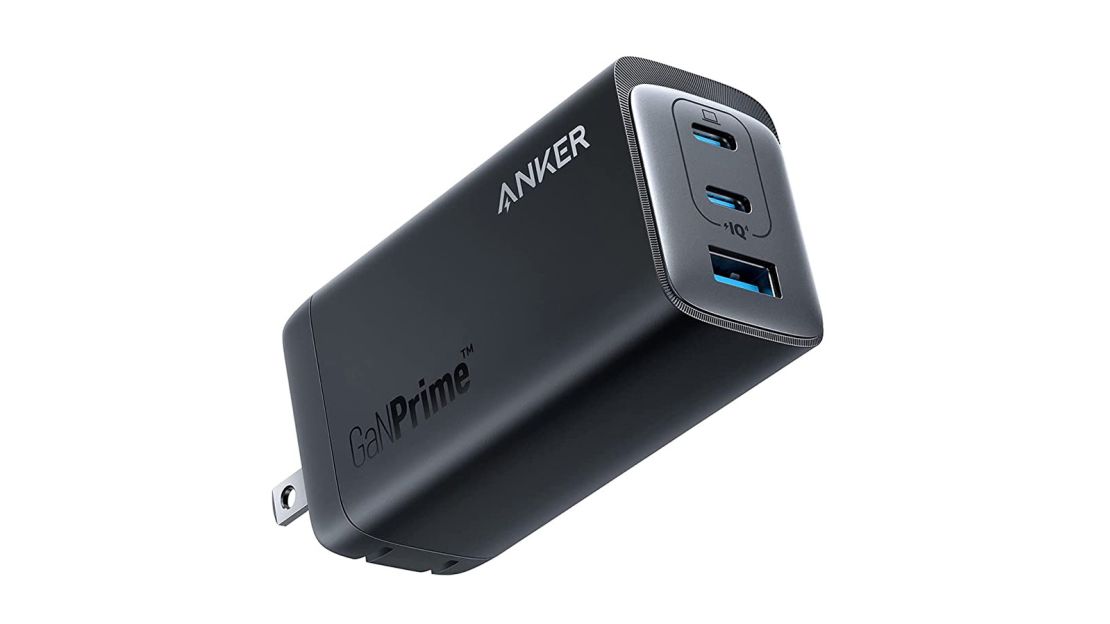
The Anker 737 provides 120W of power, nearly double the output of the Anker 735, and enough to charge larger laptops, along with a couple of other power-hungry devices (say a tablet and a large smartphone).
We never quite reached 120W in our testing; the highest total output we experienced was 103W across all three ports. However, that’s the highest out of any adapter we tested, and it’s the devices that determine the overall current draw so long as the charger is up to the task.
Furthermore, because the 737 is able to provide up to 100W of power to a laptop, it’s ideal for someone who’s looking to leave behind their laptop’s large charging brick, but not sacrifice overall speed and performance. Keep in mind, though, in order to get the full 100W of power out of it, you’ll need to stick to only using a single USB-C port when a laptop is connected.
Like the rest of the top picks with 45W or higher output, the 737 was able to charge the S23 Ultra at its full 45W fast-charging speed. It also provided 96W to the Surface Laptop Studio, while hitting 20W and 26W for the Pixel 7 and iPhone 14 Plus, respectively.
By the way, you won’t get 120W out of a single USB-C port — they are limited to 100W each when used on their own, while the USB-A port is limited to 22.5W on its own. As with the smaller 735, there are a few limitations on power distribution. When you use both USB-C ports, you’ll see up to 120W of output. The same goes for using the top USB-C port with the USB-A port. But when you use the bottom USB-C port and the USB-A port, you’re limited to just 24W of total output. And when all three ports are in use, you’ll see up to 120W of total output.
The 737 is very similar to the 735, with the same physical design, folding prongs and complement of ports, and shares the same issues with weight distribution. It’s an even bigger unit, at 1.7 × 1.25 × 3.14 inches and 6.6 ounces, and uses a similar suction cup adapter (it’s in the box) to avoid falling out of wall outlets. We can’t help but wish Anker would switch to a squatter, wider design for these units.
Balance issues aside, the Anker 737 was easily the most powerful and versatile wall adapter we tested. For that reason, it’s our top pick for charging multiple devices including a full-size laptop at high speeds.
The best budget USB-C charger: Anker 511 Nano 3 30W
$23 From $16 at Amazon
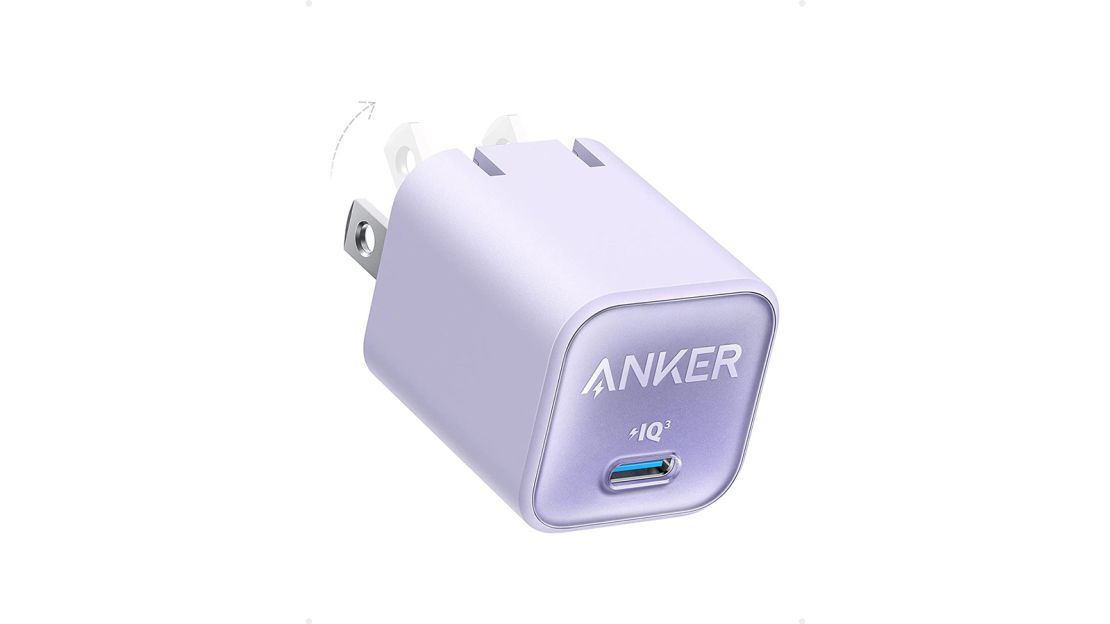
If you’re looking for a tiny, affordable charger that can go with you anywhere and still fast-charge most smartphones or even top off a tablet, then the Anker 511 Nano 3 is the best you can get, especially for the money. Like the rest of our top picks, the 511 Nano 3 uses GaN technology to keep it running cool and allowing Anker to make the brick smaller (just 1.12 by 1.12 by 1.39 inches).
With a single USB-C port, the 511 Nano 3 has a total output capacity of 30W — up from the 20W output of its predecessor, the 511 Nano Pro. In our testing, it performed as advertised. It provided 29W to the Surface Laptop Studio, 26W to the Galaxy S23 Ultra, 20W to the Pixel 7 and 26W to the iPhone 14 Plus, respectively.
While the 511 can’t fast-charge the power-hungry Galaxy S23 Ultra at top speeds, for the Pixel 7 and iPhone 14 Plus, that’s hitting those devices’ fast-charging speeds, so you’re not missing out on a whole lot when it comes to the amount of time it’ll take to charge those specific phones.
It comes in five colors, including lilac purple and natural green. On the backside of the plug, a pair of prongs folds into the charger’s housing, making it even more compact for throwing it in your pocket, purse or backpack.
The 511 Nano 3’s price, design and overall performance make it a great pick if you need something ultra-portable yet powerful enough to quickly charge your phone in a pinch.
How to choose a USB-C Charger
Now that everyone in the industry, from USB hubs to cables, has finally settled on USB-C (even Apple!) and so many gadgets support faster charging standards, there’s more demand than ever for powerful, versatile USB-C chargers.
But while the physical connector itself is now a commonly accepted standard, the world of USB-C charging is full of complexities and requires some explanation (and you’ll have to be a little cautious about what you buy, since not every device implements it in the same way). Devices with USB-C connectors share a physical plug, but the electronics and software supporting how power is delivered are a confusing array of “open” standards and each manufacturer has interpreted them somewhat differently.
But regardless of which method a particular phone uses, current technology enables very fast-charging when the battery is almost out of juice. On most current flagship phones, you can charge a near-empty battery to half its full charge within 30 or 40 minutes. Another benefit is that most of the chargers that support one of the fast-charging standards will top off the last 20% or just as quickly (Samsung phones can do this in 30 minutes).
Basically, if you upgrade from an older charger, you could save yourself some time, especially if you’re the type of person who often lets your phone run down to empty and you need to charge it in a hurry, so long as your device supports one of the USB-C fast-charging modes. Beyond that, it doesn’t make that much difference which charger you use so long as it supports the appropriate standard: only a few minutes separated our field as they charged our test devices from 25% to a full charge. Just make sure you select a charger that supplies the appropriate amount of power for your device or devices and you’ll have a good experience.
Things get a little more confusing with flagship devices that use proprietary fast-charging routines. Samsung, for instance, has a confusing array of charging modes, including fast, super-fast, and fast wireless modes, which you can enable on the devices’ Battery Settings screen. The flagship Galaxy S23 Ultra, like the past few iterations, even supports a 45W fast-charging mode.
We tested 12 different chargers that are advertised as being capable of charging devices demanding 45W of power. That’s the amount of power that Samsung’s Galaxy S23 Ultra uses for its super-fast-charging feature. But only five of those 12 adapters actually support Samsung’s fast-charging scheme and provided 45W of power to the phone. The Satechi 108W charger only managed to deliver 32W of power to the phone, since it doesn’t directly support Samsung’s fast-charging.
Many larger laptops (an Apple MacBook Pro, for example) support 96W charging, and many gaming laptops demand well in excess of 100W — beyond the capabilities of most third-party chargers. If you’re looking for a charger that can fast-charge a laptop along with other devices, you may have a difficult time and will probably be best served using the charger that came with your laptop and then finding a secondary charger for the rest of your devices — we couldn’t find a third-party charger that was flexible enough to handle fast-charging for a laptop and a current phone.
Fast-charging has been available on all iPhones since the iPhone 8. If you are using older chargers and you’re dissatisfied with charging speed, you might want to update to something newer and use a USB-C to Lightning cable.
Be aware that major power supply brands such as Anker, Mophie and Nektek have dozens of charger models, often with very similar names, and they tend to update specs on their models often, sometimes keeping those same product names. Double-check the specs and product numbers before you buy to ensure that you are getting what you want. Anker, for instance, typically gives each specific iteration of a product a number (“511”) along with a product name (“Nano 3” or “Nano Pro”).
Lastly, make sure you use high-quality USB-C cables, Lightning cables and adapters. Some USB-C cables, like those supplied with phones and other low-power devices, may only rated at up to 30W. If you’ve got more power-hungry devices, look for cables rated for 100W. And cheaply made cables may not be able to carry the higher currents and wattages, and may not power your devices or even be a fire hazard, especially if you’re using a 100W charger. Some chargers come with appropriate USB-C-to-C or USB-C-to-lightning cables just to ensure that you are getting the best experience possible with your power delivery. And be careful if you are using the 60W or 100W models on older equipment; we blew out one of our laptop’s USB-C ports when doing the tests.
What exactly is a GaN charger?
All of the chargers we tested in the latest round use Gallium nitride (GaN) technology. Gallium nitride is a crystalline material that conducts electricity more efficiently than silicon, which has long been the most commonly used material in solid-state electronics.
Since GaN is a better conductor, circuits built with it stay cooler, which means components can be built smaller, with greater power-handling capacity. And that in turn means manufacturers can make smaller, lighter devices that are more powerful and capable — and in the case of chargers, can provide faster charging speeds.
You’ll see some proprietary naming conventions around (Anker advertises that their devices use “GanPrime,” for instance). But those are just fancy marketing names for a combination of GaN technology and software that monitors the device’s temperature and optimizes power distribution.
How we tested
We focused our testing on two main aspects: design considerations and performance.
Design
- Overall dimensions and charging capacity. The chargers we tested fell into four rough categories. The most basic chargers typically come in small one-inch cubes that have fixed prongs on one end and one USB port on the opposite end. They typically deliver 18W to 30W of power, and are suitable for charging a single device. The next group is slightly larger, typically offers a couple of ports and is rated in in the 45W range. The third group, meant more for smaller laptops and larger tablets, is rated around 65W. Finally, the most expensive and largest chargers can deliver 100W or more, are sufficient for mainstream laptops and usually come with multiple USB ports.
- Number of USB ports. Most of the basic chargers we tested offer a single USB-C port. Once a device maker starts adding two or three USB-C ports and a traditional USB-A port, then the output also increases. Not only do you have to take the number of ports into account, but not all ports are created equal on these chargers. Some chargers with multiple USB-C ports limit output to specific ports in order to provide fast-charging along with legacy support, but for many you have to share the overall power across multiple ports, meaning you can’t fast-charge multiple devices (or in some cases, fast-charge anything if multiple devices are connected).
- Build quality. All of the chargers in this test batch had what we felt was sturdy build quality, with Anker’s products offering a premium look and feel, even if it was at the cost of adding extra weight.
- Fixed or foldable prongs. This is an important aspect of the overall design for all chargers that helps with portability. If the wall adapter prongs are fixed, it increases the overall packed size of the charger. Additionally, it forces you to pay attention to where you pack the charger due to the prongs having the potential of scratching your device’s screen if you toss everything into a backpack or piece of luggage.
- Charging circuitry. For years, chargers used the same silicon-based circuits that were used in the portable devices they connected to. Many recent devices are based on gallium nitride or GaN instead. This material has two big advantages. First, it conducts electricity more efficiently than silicon; second, it dissipates heat better. That means chargers can be much smaller while delivering the same amount of power and they can run a lot cooler, particularly important for those that supply a lot of power. There’s no reason not to buy a GaN charger at this point, and everything we tested in our latest round uses the material.
- Warranty period. Nearly all of the USB-C chargers we tested offer a 24-month warranty. All Anker chargers come with 18-month warranties. Satechi, Nekteck and Samsung offer a 12-month warranty period for their chargers.
Performance testing
Every time you connect your phone, tablet or laptop to a charger, the device’s internal hardware and software communicate with the wall adapter’s software and hardware to negotiate a charge rate based on a number of factors, including the total capacity of the charger, if the device is currently in use or sitting idle and the current charge level of the battery. The lower the battery’s charge level, the faster it can and will typically charge.
With that in mind, we kept the battery level of all devices used in testing under 50% during the testing process. Each device had its screen brightness set to 100%, and had a YouTube video streaming in full-screen mode.
We would then connect the necessary cable to the device and each charger, monitoring the charging speed displayed on the cable’s LED display or the Klein Tools analyzer.
We would repeat this process for each port on an adapter to test each port’s output. We would then connect a device to all available ports on an adapter and check that the ports were providing their full potential output, as well as add up the total output of the charger and compare it to the advertised capacity.
As a baseline, we tested the voltage output of each port on each device, both at initial charge and with a nearly full charge, and compared delivered power versus promised or rated power. Then we conducted charging speed tests as follows:
- Time to get to a 50% charge from less than 10%. (Most of the newer devices manage power draw and boost it when batteries are low. Apple phones slow things down after 75% and Samsung after 90% so as to not damage batteries.)
- Time to reach a 100% charge from a battery depleted to less than 10% full.
We used the following devices for testing:
- A Klein Tools ET920 USB analyzer was used to monitor the total output of each power adapter and a Lightning cable to connect to an iPhone 14 Plus.
- We used multiple Mcdodo USB-C to USB-C cables with an LED Display to monitor each port’s output in real time when connected to a device.
- When testing standard USB-A ports, we used the Mcdodo USB-A to USB-C cable with an LED Display to monitor output in real-time.
- An iPhone 14 Plus with a maximum charging speed of up to 30W.
- A Google Pixel 7 with a maximum charging speed of up to 20W.
- A Samsung Galaxy S23 Ultra with a maximum charging speed of up to 45W.
- A Microsoft Surface Laptop Studio with a maximum charging speed of up to 96W.
- An HP Elitebook 850-G2 laptop with USB-C ports rated at 20v and 3.3A.
- An iPhone 12 mini with 2.227 Ah battery.
- A Samsung Galaxy S21 with 4 Ah battery that supports 25W PPS super-fast-charging standard.
Other USB-C chargers we tested
Anker 511 Nano Pro 20W
$17 $14 at Amazon
If you find it on sale, our former budget pick and older version of the Anker 511 is still a great choice for anyone who needs a basic wall adapter to power something like Apple’s HomePod Mini. But for the money, you can get Anker’s updated 511 Nano 3 30W charger that’s better suited for charging smartphones.
Apple 20W USB-C adapter
$19 $14 at Amazon
We never got anywhere near 20W from this unit, and similar units from Anker with a single USB-C port charged our devices faster. (For the Samsung S21, it delivered 14.3W and for the iPhone 12, it delivered 13.5W initially.) Apple’s USB-C charger is also larger than the similarly spec’d and more capable Anker units.
Google PixelBook 45W USB Type-C Charger
Currently unavailable at Amazon
We were able to get 41W from this unit’s single USB-C port, but despite its support for PD v3, other chargers delivered more power at lower cost. (For the Samsung S21, it delivered 14.5W initially.) Google also places the power prong at a 90-degree position from the USB port, making it somewhat inconvenient to arrange on your wall or fit behind your furniture. It comes with a double-sided USB-C cable.
Belkin BoostCharge Pro 20W USB-C PD GaN Wall Charger
From $13 at Amazon
This charger has a unique design that is long and thin, and instead of coming straight out from an outlet. The skinny design definitely makes it easier to slide into your back pocket or even a smaller spot inside a backpack. It’s great for travel.
Satechi 30W USB-C PD GaN Wall Charger
$30 at Amazon
This 30W charger from Satechi is one of the larger wall adapters in this range, even when you take the collapsible prongs into account. It hits its 30W marks, but overall size and price are what kept it from our top picks.
Mophie Speedport 30W GaN Fast Wall Charger
$30 From $21 at Amazon
The 30W Mophie Speedport has a lone USB-C port that hits all of its performance marks across the board. It’s well-designed, and only slightly larger than our budget pick. It’s more expensive, but Mophie products are good quality, and you won’t be upset if you end up going this route.
Spigen ArcStation Pro GaN 352 Dual USB-C Wall Charger
$40 $33 at Amazon
The Spigen ArcStation Pro 352 has two USB-C ports, each one capable of providing 30W of total power. You can squeeze 35W of total output from the 352 when using both ports, with 25W coming from the top, 10W from the bottom port. It’s a compact adapter but has fixed prongs.
Samsung 45W USB-C Fast-Charging Wall Adapter
$35 $29 at Amazon
Samsung’s 45W USB-C wall adapter is designed specifically for fast-charging — or as Samsung calls it, super-fast-charging — its Galaxy smartphones. It did its job when charging the S23 Ultra, but it’s pricey for a single-port USB-C charger. Not to mention it has fixed prongs. Unless you want to go first-party all the way for your Samsung phone, there are better options available.
Nekteck 65W USB-C Charger GaN PD 3.0
$40 $31 at Amazon
Nekteck’s 65W USB-C Charger is a really good deal given its price and total output of 65W, but with only a single port and no support for Samsung fast-charging (our Galaxy S23 Ultra only pulled 31W out of 45W), it didn’t quite make the cut. If you need an affordable, single-port, compact charger that’s around the 65W mark for charging anything but a Samsung phone, then this is a solid pick.
Belkin BoostCharge Dual USB-C PD GaN Wall Charger 68W
$65 $40 at Amazon
The BoostCharge’s performance when charging a Galaxy S23 Ultra was the worst out of the 65W+ models, providing 24W out of a potential 45W of power. The adapter has a unique way of handling power to its ports, with the top port always limited to 20W of output and the bottom port offering a range of 50 to 60W, with a maximum output of 68W.
Spigen ArcStation Pro GaN 652 Dual Port Wall Charger
$60 $49 at Amazon
The ArcStation Pro from Spigen has two USB-C ports, each one capable of 65W of output when used on its own. When you have two devices plugged into it, the top port gives 40W, with the bottom port offering 25W of power. While the overall size is somewhat compact, the prongs do not fold down for easy traveling.
Nomad 65W Power Adapter
$70 at Nomad
Nomad’s 65W power adapter has two ports for a total of 65W of power. You’ll want to use the top port for your energy-hungry devices, as it’s the only one that will output the full 65W when used alone, or 45W when the bottom port is also in use, with it maxing out at 20W. It’s one of the smaller 65W adapters we tested, thanks in part to the prongs folding in.
Otterbox Premium Pro Fast-Charge 72W
$70 at Otterbox
Otterbox’s 72W charger has three total ports, two USB-C, and one USB-A, that team up to offer a total of 72W of power. The USB-A port keeps 12W of power for itself at all times, while splitting the remaining 60W of power between the USB-C ports (1 at 60W or 2 at 30W each). Even with 60W total output from a single USB-C port, it stopped well short of providing 45W total power to Samsung’s S23 Ultra, with a measured 28W of output.
Satechi 108W Pro USB-C GaN Wall Charger
$75 at Amazon and Satechi
This charger doesn’t stick straight out from the wall like Anker’s chargers, but instead goes straight down, where you’ll find three USB-C ports with a 108W of total output. It carries a one-year warranty and you need to pay really close attention to which ports you’re using to maximize charging speeds.
Ugreen Nexode 140W USB-C Wall Charger
$110 at Amazon
The Ugreen Nexode 140W USB-C Wall Charger has a total of three ports, two USB-C and one USB-A with a total output capacity of 140W. Included with the charger is a 1.5m USB-C cable. It’s the largest charger out of those tested, even though the prongs fold in. Despite an advertised 140W of total output, we saw it max out at 96W on the USB-C ports.
Anker PowerPort III 2-Port 60W USB-C charger
Currently unavailable at Amazon
This travel-oriented charger from Anker comes with interchangeable prongs for US, UK and EU outlets. The prongs fit in the opposite side of where its two USB-C ports are connected. It is adequate for powering two phones simultaneously, although not the fastest of other Anker chargers. It delivers a range of voltages from 5 to 20V.
Anker Nano II 30W
$24 at Amazon
Rated at 30W, the older Anker Nano II provides more power than you need for most phones. What was impressive was that it could deliver 22W to fast-charge our Samsung S21 starting from a 10% battery level. This is better than many of Anker’s more expensive chargers. However, it initially only delivered 13W to the iPhone 12. It is based on GaN electronics and comes with a USB-C-to-Lightning cable.
Spigen PowerArc Arc Station 40W
$36 $30 at Amazon
While it initially seems attractive for its two USB-C ports, GaN electronics, and 40W rating, it will only supply a maximum of 30W power over a single port, and you can only get up to 20W per port if you use both. The rating is somewhat misleading, and you may be better off using two chargers if you have one device that requires more power than another to charge. The charger measures 2 by 2 by 1 inches with a retractable power prong.
Nekteck 60W USB-C charger
$44 $30 at Amazon
Based on GaN circuitry, this has a single USB-C port that we measured at 55W output. It comes with a USB-C-to-USB-C cable and has a foldable power prong.
Satechi 100W USB-C PD
$80 at Amazon
Satechi’s 100W charger has two USB-C ports and one USB-A. It uses GaN technology and has a separate AC power cord that attaches to the unit. It supports PD PPS for fast-charging Samsung devices that support that standard. If you use either USB-C port alone you can get the full 100W, but if you charge two USB-C devices concurrently, you’ll get 60W in the top one and 30W in the bottom one, though both are labeled as “100W” ports. The Anker Atom PD4 did a better job distributing power to its four ports.
